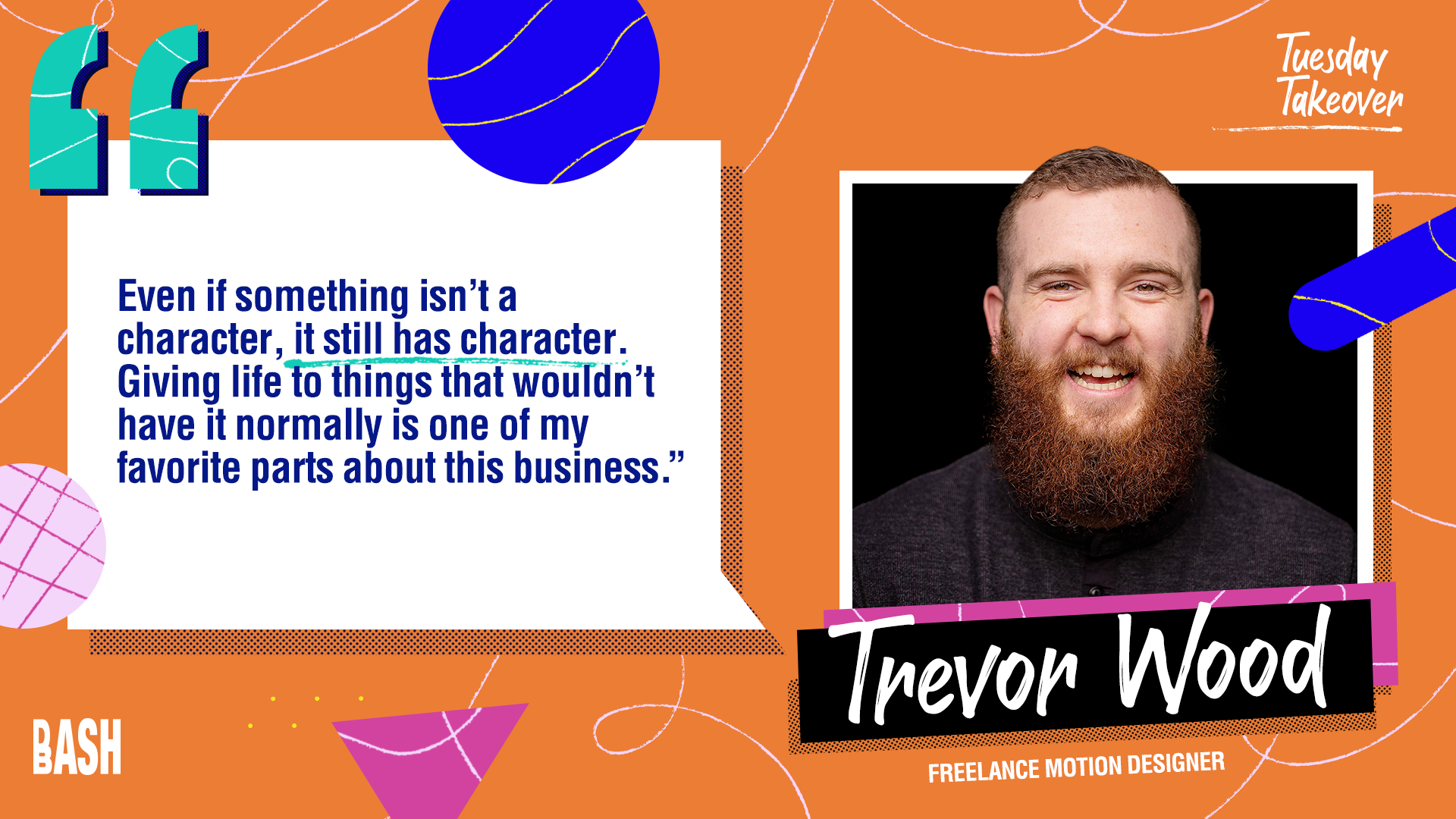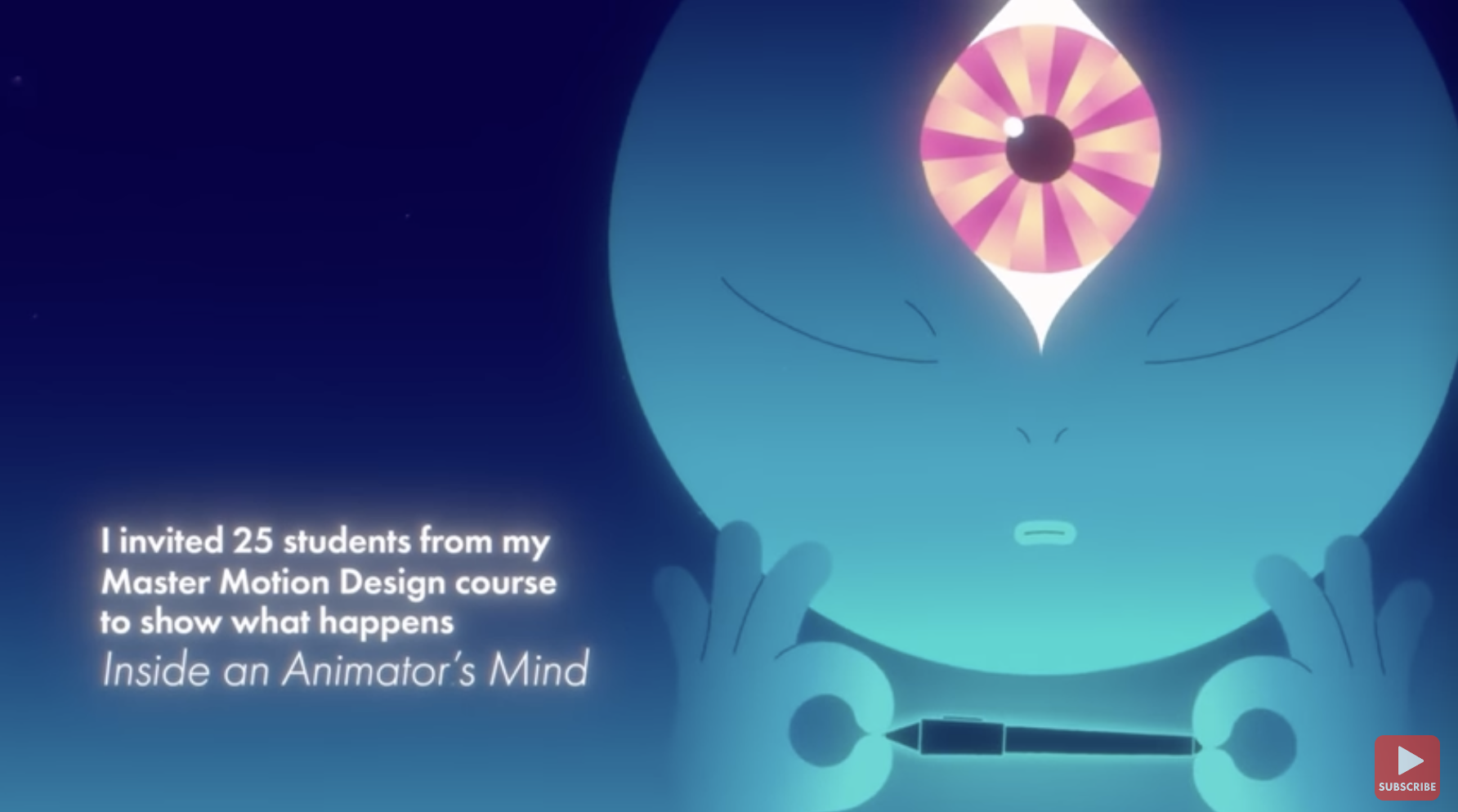Takeover Tuesday with Trevor Wood
An interview with Trevor Wood: a motion designer based in Champaign-Urbana, IL.
Interviewer: Matea Losenegger.
Read time: 5min
Matea:
Thank you for giving us your time! Can you introduce yourself and what you do?
Trevor:
My name is Trevor Wood and I’m a motion designer based in Champaign-Urbana, IL. I live here with my beautiful wife and adorable rescue dog. When I’m not animating you’ll find me at one of the local open-mic nights or on the couch playing Fortnite.
Matea:
You have a vast range of video production experience. How does the work from your time with WCIA 3 compare to commercial production?
Trevor:
I still use a lot of the same processes, techniques, and software I learned while at WCIA 3. The video production pipeline is pretty similar whether it’s for a local boutique or a big clothing brand. Budgets may be different, but it all comes down to the story you want to tell and how you tell it.
Looking back, I was super lucky to get that job because I had the chance to learn a lot of different things like live camera operation, audio engineering, and video editing. I’ve even shot aerial footage from a helicopter, which was a highlight for sure. But the main thing I did was shoot and produce local TV commercials. The ones with that certain charm you can only get on local broadcast television. I loved embracing the format and its limitations, and I still try to infuse some of that charm into every project.
Matea:
What made you decide to freelance full time and what was that transition like?
Trevor:
The idea of owning my own business has always appealed to me, ever since I got my first job at a small family-owned grocery store. At one point I wanted to open my own coffee shop even though I didn’t yet drink coffee. It sounded cool to be in charge and make my own decisions. Later, in college I was able to make some extra money on the side doing graphic design and photography. When the pandemic hit I started working from home and I constantly found myself going down motion design YouTube rabbit holes. Eventually someone recommended reading the Freelance Manifesto by Joey Korenman and it felt like Joey was speaking directly to my soul. From that point on all I could think about was going freelance as a motion designer.
After making the decision to go freelance, the transition took much longer than I expected. About two years from start to finish. I was still a little rusty with motion design and had to really refine my chops. I also had no idea how to run my own business, so on my commutes I started listening to all of the podcasts from Motion Hatch, The Futur, and School of Motion. I started doing work on the side after hours and saving all of the extra money I made to create a financial cushion just in case things slowed down. Eventually I had to start turning down work because there was so much demand and that’s when I knew it was time to quit my job and go full-time. After I hit my financial goal, I went freelance in July 2022.
Matea:
You recently collaborated with Ben Marriott. What was your experience working with him and the team he pulled together?
Trevor:
Collaborating with Ben was a dream come true. He started getting big on YouTube right around the time I started pursuing a freelance career. So when he launched Master Motion Design course, I was first in line. I was chosen for the collab based on my work for the course and joined 24 other exceptional students to create the Inside an Animator’s Mind collab. Everyone who was part of the collaboration was so nice and it felt great to be part of such an amazing group. Leading up to the launch we all shared our work in a private forum and had the chance to see Ben’s fantastic intro come to life. It was awesome, and one of the biggest highs of my career so far.
Matea:
Whether it be for a passion project or for a client, what is the secret to cultivating a strong collaborative environment?
Trevor:
As artists, our work is often very personal because it’s a reflection of ourselves and our experiences. But to cultivate a strong collaborative environment it’s important to focus on what’s best for the project as a whole and not what’s best for the individual. That can look different whether you’re working with a client or on a passion project. When I’m working with a client, I try to make sure every decision I make is what’s best for the goals of the project and doesn’t just satisfy my artistic desire. If I’m working with others, I’m constantly asking myself, is this what’s best for us, or is this what’s best for me?
Other than that, just be a good human. You don’t have to be the best artist. I’m certainly not. Just be kind, friendly, and helpful. Those are the main ingredients to a strong collaborative environment.
Matea:
While it goes without saying you have some fun character work, I noticed even your text and graphic animations have a lot of charm. What's your process in giving personality to something that's not necessarily a character?
Trevor:
Even if something isn’t a character, it still has character. Giving life to things that wouldn’t have it normally is one of my favorite parts about this business. My process is iterative, which means I animate the biggest movements first, then refine with secondary motion, overshoot, and anything else that feels right. I use my hands a lot to get a better understanding of how I want the movement to feel, and I use my breath to help make the timing feel natural. Then I’ll spend as much time as possible in the graph editor to make sure every keyframe is perfect (or at least close enough).
Matea:
Where are some unexpected places you've gotten inspiration from?
Trevor:
It’s hard to pinpoint exactly where my inspiration comes from. There are so many talented artists out there that are constantly inspiring and challenging me with their work. But probably the most unexpected place I find inspiration is in restaurants. Whenever I go out to eat with my wife I have to make sure there are no TVs within my line of sight, otherwise I won’t hear a word she says to me the entire time. We cut the cord a long time ago, so I rarely see broadcast commercials. So as I’m waiting for our food to arrive, I find myself captivated by them, trying to figure out how they did the graphics, wondering which studio worked on the animation, who designed the style frames. And since the commercials aren’t targeted like most of the ads I see, I get to see animation that’s totally different than my Instagram algorithm feeds me and I find it all very inspiring (and entirely distracting).
Matea:
What is your favorite type of project to work on?
Trevor:
I love when I’m given a project with very clear brand guidelines. I enjoy the challenge of drawing within the lines and knowing the rules (and sometimes breaking them on purpose). It may sound counterintuitive, but I feel paralyzed when a project has an open brief or too much creative freedom. I like to have a bounding box to play in.
Matea:
Is there a style or type of animation you'd like to explore more?
Trevor:
I started learning Blender this year to explore the hybrid 2D/3D style. I just find the mix between those two main styles of animation very interesting. You might have line work at 12fps while something else with photo-real geometry and textures is happening in the background. The possibilities of hybrid styles in general is super exciting.
Matea:
Is there anything you're excited to share this year?
Trevor:
Some friends and I just dropped a collab we’ve been working on since the start of the year. It was a twist on the game telephone where we had to create a story while only knowing what came immediately before. The story doesn’t make much sense in the end but it’s a fun time. I’d love to do more collab projects this year — It was a great time.





